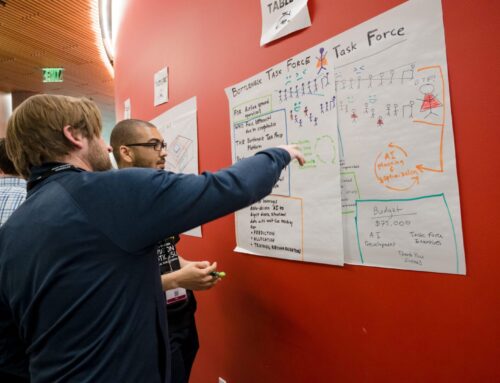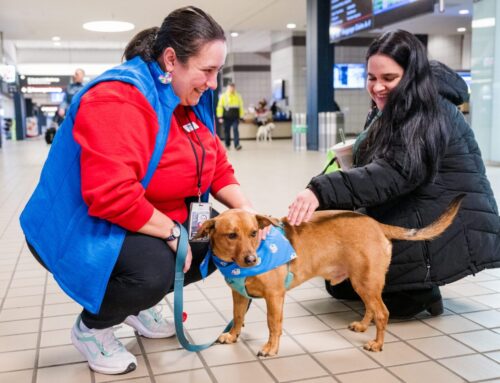Part 1: How PIT Survived the Pandemic
The inside story of how Pittsburgh International Airport weathered the most devastating year in aviation history
By Blue Sky Staff
Published January 17, 2021
Read Time: 7 mins
The coronavirus pandemic of 2020 approached the United States like a gathering storm. A few dark clouds on the horizon, followed by reports of isolated showers and then, seemingly all at once, the sky fell in. The devastation was swift and widespread, but no economic sector short of health care may have felt the shock more than aviation. On pace in February to set yet another record year of commercial air travel, in March the industry came close to collapse.
Airlines were the most visible emblem of the pandemic’s reach, as carriers grounded planes and passenger bookings evaporated. Almost immediately, airlines began trimming their budgets, canceling flights and contemplating layoffs, all in an effort to stay solvent.
Airports had no such recourse. As part of the nation’s critical infrastructure, they had to stay open and fully operational for cargo, military operations and the few passengers that still needed to fly.
Click here to experience this story in a full multimedia format
“We knew we needed to stay open no matter what – and that meant keeping our own teams safe and healthy so we could take care of everyone who had to travel – so we could remain open for cargo and our military,” Allegheny County Airport Authority CEO Christina Cassotis said. “I remember April 2010 when the Icelandic volcano caused the shutdown of many of Europe’s airports for six days in 2010. That was a wake-up call for some about the importance of airports – no matter how small or how local – and the important role airports play in people’s daily lives. And that was before a pandemic.”
This is the story of how one airport—Pittsburgh International—absorbed the pandemic’s blows and condensed years’ worth of planning into a few weeks to enact health and safety measures to protect passengers and staff, all the while preparing for the day when business and leisure travelers would once again take to the skies.
Photographs by Beth Hollerich | Video by Natalie Fiorilli and Beth Hollerich
Part 1: Buckle Up
On Dec. 1, 2019, the end of the Thanksgiving holiday weekend, more than 2.8 million travelers passed through security checkpoints nationwide, according to the Transportation Security Administration, the busiest day ever in the 18-year history of the agency.
That capped off a year in which U.S. airlines carried 925.5 million passengers—the most since 2003, according to the federal Bureau of Transportation Statistics. Annual passenger totals had risen steadily for years and everyone expected the trend to continue in 2020.
February 2020 – PIT passenger volume: 677,252
Then COVID-19 changed the world and, in the last two weeks of March, commercial air traffic came to a virtual halt.
On Feb. 3, with fewer than a dozen cases of COVID-19 in the U.S., the Department of Homeland Security requires travelers from China to enter the country via one of 11 designated airports and imposes a 14-day travel ban on all visitors from China, where the virus originated and had already killed 360 people.
With no direct flights from China, Pittsburgh International is not one of the restricted airports. But PIT officials, like their counterparts across the country, had already started planning to combat the virus and brace for what might happen next.
On Feb. 20, the International Air Transport Association estimates that COVID-19’s dampening effect on passenger demand would result in a nearly $30 billion loss for carriers worldwide, with the bulk of the damage hitting airlines operating in the Asia Pacific region.
Alexandre de Juniac, IATA’s director general and CEO, predicted that global traffic would drop nearly 5 percent as a direct result of the virus.
Soon after, the PIT team creates its own forecast scenarios with the best case being a 30 percent decrease in annual traffic and a worst case at a 70 percent drop. These forecast scenarios are critical for financial modeling and to see where costs can be delayed, deferred and cut.
By the end of the year, revenue losses for airlines worldwide would total $115 billion and passenger traffic would fall by almost 60 percent.
A robust internal response
March 6, 2020: 423 confirmed COVID-19 cases in the U.S. (10 in Pennsylvania) and 19 deaths
The airport introduces new safety policies for staff, including mask wearing and social distancing, and increases sick time availability for anyone who becomes ill. Officials roll out a voluntary furlough program for employees who are uncomfortable coming to work and those with demanding family situations, such as young children. The airport’s first early retirement program follows. Certain job duties are changed to allow on-site staff to be able to work in socially-distant manners. Plexiglass barriers are installed for customer service reps, one person per vehicle rules instated for airfield and facilities maintenance workers and electricians working in close quarters had job changes.
The Authority develops a robust internal communications protocol to provide employees updates on COVID-19, the official designated name for the novel coronavirus, including a dedicated section of the Authority intranet site and multiple staff-wide emails each week.
Airport leadership’s first thought was keeping the team healthy and managing their anxiety against so many unknowns.
“We didn’t want people coming to work sick because they were afraid of losing their sick time. And we needed to make sure we had enough qualified and trained people to keep our airport open – no matter what,” Cassotis says.
“We pegged the CDC and our state and county health departments as the parties whose policies and recommendations we would follow. Our very first COVID-19 policy allowed ACAA staff know that if they needed to quarantine because they had been contact-traced or because they had contracted COVID-19, that their sick time would not be impacted.”
The CEO begins weekly all-employee calls for all three shifts to keep everyone up to date. Some staff begin working remotely, but the CEO emphasizes that the airport must stay open for flights, passenger, cargo and to support the two military bases on airport property.
Cleaning at eye level
PIT introduces new healthy travel protocols to enhance deep cleaning routines in the terminal, including restrooms and other common areas. Crews clean more frequently at all high-touchpoint areas, including handrails, elevator buttons, door handles, tables and chairs. They pay close attention to the airport trains, wiping down the hold bars and railings.
“The airport and airline industry have faced the threat of communicable disease before and have developed, trained and executed emergency plans and drills,” says April Gasparri, Senior Vice President of Public Safety, Operation and Maintenance at the Allegheny County Airport Authority.
Staff install hand-sanitizing stations at about 30 locations throughout the airport.
“What’s changed for us is that typically our people are looking downward, looking at the floor and that area for the most intensive cleaning,” says Rege Koslof, supervisor for ISS, PIT’s contracted cleaning service. “Now it’s a redirected focus. They’re looking at eye level for touchpoints like door handles, switch plates, handrails and things like that to clean.”
Getting the word out
The airport’s news service — Blue Sky News — is integral during the pandemic. The publication begins covering the preparation and industry impact on Jan. 27 and later publishes more than 200 stories, including video stories, throughout the year.
Produced in-house, Blue Sky focuses on the impact to the aviation industry — nationally and internationally — as well as on Pittsburgh International Airport and the region’s stories. The result is direct communication with thousands of subscribers in a time of crisis, numerous media pickups and an outlet for PIT leadership to communicate with the world.
In an essay on Blue Sky News, Cassotis warns that the pandemic is uncharted territory for the airline industry and potentially worse than the aftermath of the Sept. 11, 2001, terrorist attacks.
Finding a parking space
March 2020 – PIT passenger volume: 399,897, down from 837,561 in March 2019
By mid-March, the fallout from the outbreak hits aviation hard, with widespread flight reductions and cancellations.
With all the cuts, the industry is suddenly confronted with an extraordinary problem: where to park all those idle aircraft.
PIT’s airport operations team begins talking with the airlines.
Pittsburgh International is an ideal location for aircraft diverted by weather or other issues, because of its location, size, number of runways and equipment. This is one of those issues.
American Airlines ferries five of its Airbus A330 aircraft to Pittsburgh from Philadelphia International Airport and Charlotte Douglas International Airport.
“Our changes will vary based on the way the airlines are operating,” says Patrick Carreno, Vice President of Airport Operations for the Allegheny County Airport Authority. “We want to stay ahead of the game and put our best foot forward to best accommodate airlines and passengers for what they need right now.”
At the beginning of the year, the airport had been planning to accommodate a different sort of unusual activity on its airfield: the billion-dollar Terminal Modernization Program, or TMP, which aimed to build an entirely new terminal to handle ticketing, baggage, security and arrival and departure traffic.
The TMP is put on hold because of the pandemic, much like most other major construction projects in the region. Airport officials say they remain committed to the project that staff and contractors had spent years planning.
By the end of the month, nearly 100 planes sit idle on PIT’s airfield, including on one of its four runways as well as on taxiways and aprons.
Bryan Dietz, Vice President of Air Service Development, estimates the airport can handle approximately 140 aircraft.
“First and foremost, we want to give the airlines a way to respond to this drop in travel demand,” he says. “We want to give them a place that they can easily and efficiently consolidate their aircraft parking.”
In an April 6 video for Blue Sky News, CEO Christina Cassotis is unequivocal. “We’ll be here, supporting our partners.”







